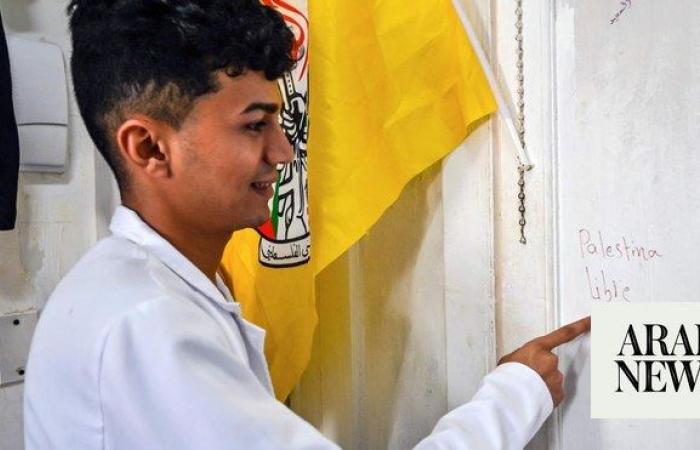Thank you for reading the news about Palestinian medical students in Cuba highlight pain of diaspora and now with the details
Jeddah - Yasmine El Tohamy - NEW DELHI: Indian Prime Minister Narendra Modi inaugurated on Monday a new campus of Nalanda University, an institution located at the site of a 5th-century learning center considered the world’s first residential university.
The ancient Nalanda university in the state of Bihar was founded in 427 CE during the Gupta empire and flourished for more than seven centuries. Its archaeological remains became a UNESCO World Heritage site in 2016.
The present-day Nalanda University was established in Nalanda district as a public research university by an act of the Indian Parliament in 2010. A flagship project of the Ministry of External Affairs of the government of India, it was proposed by India’s former president A.P. J. Abdul Kalam and Nobel laureate Amartya Sen, who served as its first chancellor.
Supported by 18 member countries of the East Asia Summit, Nalanda University’s first batch comprised a dozen students enrolled in graduate and postgraduate courses in 2014. The construction of its new campus started in 2017. It was announced as a “net zero green campus,” with solar panels and water treatment and recycling plants.
“It’s a very special day for our education sector,” Modi said during the inauguration ceremony attended by Bihar Governor Rajendra Arlekar, Bihar Chief Minister Nitish Kumar, Foreign Minister S. Jaishankar, and foreign ambassadors.
“Nalanda has a strong connect with our glorious past. This university will surely go a long way in catering to the educational needs of the youth.”
The ancient Nalanda, whose complex spread over an area of 23 hectares, attracted thousands of students arriving from China, Indonesia, Korea, Japan, Mongolia, Sri Lanka and Tibet to learn medicine, logic, mathematics and Buddhist teachings. It also sent some its best professors to propagate Buddhist philosophy in learning centers across Asia.
“Ancient Nalanda had come up in the 5th century CE and this used to be one of the prime institutions of not only Asia but of the world, because it was the first residential university of the world,” Nalanda University Vice-Chancellor Prof. Abhay Kumar Singh told Arab News.
“The new university is situated at the same place where you have the ancient campus ... Lots of authentic literature on philosophy was produced. Not only philosophy. Sanskrit, grammar, Ayurveda, metallurgic arts, cosmology, astrology and astronomy — all these things were studied here.”
There are conflicting reports on who destroyed the ancient campus. Some Indian historians believe that it was the Turko-Afghan military general Bakhtiyar Khilji during his conquest of northern India, while many Buddhist sources blame local Hindu Brahmins who they say were jealous of Buddhist dominance at that time.
What is undisputed is that when Nalanda was burnt down in the 12th century, most of its scholars fled to Tibet, and exchanges with other Asian learning centers stopped.
“They lost their source of knowledge. These interactions ended 800 years ago ... In 2006, former president Abdul Kalam suggested that we should have ancient Nalanda rejuvenated again. At the same time there was an East Asia Summit. Member countries also suggested that we want the same Nalanda to be revived and we would support the Indian government to establish the center,” Singh said.
“The university was established and 2014 was the first batch of students, just 10 or 12 ... Now we have students from 26 countries. Although the number is not high, the representation of all these countries is here. It’s truly an international university.”
In the past semester, the university had 170 foreign and 50 Indian students enrolled in world peace, Buddhism, comparative religion, philosophy, literature and management courses.
Soon it will be ready to receive more students at the new complex, which has two academic blocks with 40 classrooms and total seating for about 1,900.
“Earlier we were functioning from temporary facilities. This campus has the capacity to accommodate about 7,000 to 8,000 people — both teaching and non-teaching staff combined,” Singh said.
“We initially planned to have more than 2,000 students and for this we need more courses. Right now, we have six master’s degrees and every course takes 40 students. We are now adding more master courses and more students will join.”
These were the details of the news Palestinian medical students in Cuba highlight pain of diaspora for this day. We hope that we have succeeded by giving you the full details and information. To follow all our news, you can subscribe to the alerts system or to one of our different systems to provide you with all that is new.
It is also worth noting that the original news has been published and is available at Arab News and the editorial team at AlKhaleej Today has confirmed it and it has been modified, and it may have been completely transferred or quoted from it and you can read and follow this news from its main source.


